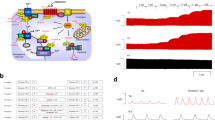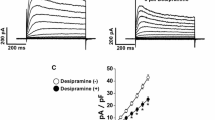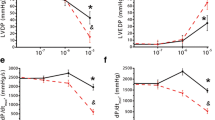Summary
The mode of action of tryptamine was investigated on strips of left circumflex coronary artery of calf. 1) Exposure to (−)-deprenyl, an irreversible inhibitor of monoamine oxidase B, markedly potentiated the contractions caused by tryptamine but not those by 5-hydroxytryptamine (5-HT). Experiments were therefore carried out on arteries treated with (−)-deprenyl. 2) Tryptamine, administered non-cumulatively, elicited fast developing contractions, which partially faded. The intrinsic activity for the peak response to tryptamine was 0.8 compared to 5-HT. Ketanserin competitively antagonized the tryptamine-induced contractions with a K B of (−log mol/1) 9.9. Methysergide antagonized the effects of tryptamine in a noncompetitive manner by depressing the maximum response with an IC50 (−log mol/1) >9.0. 3) Tryptamine caused unsurmountable depression of 5-HT-induced contractions with an IC50 (−log mol/1) of 6.4. Ketanserin also competitively antagonized the depressant effects of tryptamine on 5-HT-induced contractions with a K B of (−log mol/1) 9.9. 4) At high concentrations of tryptamine (0.2−1 mmol/l), the fast developing contractions were followed by slowly developing contractions. Methysergide 1 nmol/l enhanced maximally the slow developing contractions. 5) These findings are consistent with an interaction of tryptamine at different sites of the allosteric 5-HT2-receptor system: (I) Tryptamine competes with ketanserin for the 5-HT2-receptor in the highly active R state. Binding of tryptamine to the R state would cause the fast contraction. (II) Tryptamine competes with ketanserin for the allosteric site. Tryptamine induces allosterically a shift from R to the low active R′ state as methysergide does, thereby depressing the response to 5-HT. Ketanserin restores the response to 5-HT depressed by tryptamine. (III) Tryptamine appears to bind also to the R′ state of the 5-HT2 receptor thereby causing the slowly developing contractions.[/p]
Similar content being viewed by others
References
Arunlakshana O, Schild HO (1959) Some quantitative uses of drug antagonism. Br J Pharmacol 14:48–58
Beck O, Flottberg G (1984) Measurement of endogenous tryptamine in rat brain by capillary column gas chromatography mass spectrometry. Biomed Enviran Mass Spectrom 11:155–158
Barbaccia ML, Costa E (1986) Endogenous ligands for the 3H-imipramineand 3H-ketanserin recognition sites. Clin Neuropharmacol 9 (Suppl 4):223–225
Blinks JR (1965) Convenient apparatus for recording contractions of isolated muscle. J Appl Physiol 20:755–757
Caramona MM (1982) Monoamine oxidase of types A and B in the saphenous vein and mesenteric artery of the dog. NaunynSchmiedeberg's Arch Pharmacol 319:121–124
Caramona MM (1983) Localization of monoamine oxidase of type A and B in blood vessels with different innervation patterns. Naunyn-Schmiedeberg's Arch Pharmacol 324:185–189
Clancy BM, Maayani S (1985) 5-Hydroxytryptamine receptor in isolated rabbit aorta: characterization with tryptamine analogs. J Pharmacol Exp Ther 233:761–769
Frenken M, Kaumann AJ (1984) Interaction of ketanserin and its metabolite ketanserinol with 5-HT2-receptors in pulmonary and coronary arteries of calf. Naunyn-Schmiedeberg's Arch Pharmacol 326:334–339
Frenken M, Kaumann AJ (1985) Tryptamine interacts with both the 5-HT2-receptor and the allosteric site in bovine large coronary artery. Pflügers Arch 403: R32
Frenken M, Kaumann AJ (1987a) Allosteric properties of the 5-HT2-receptor system of the rat tail artery. Ritanserin and methysergide are not competitive 5-HT2-receptor antagonists but allosteric modulators. Naunyn-Schmiedeberg's Arch Pharmacol 335:359–366
Frenken M, Kaumann AJ (1987b) Interconversion into a low active state protects vascular 5-HT2-receptors against irreversible antagonism by phenoxybenzamine. Naunyn-Schmiedeberg's Arch Pharmacol 335:481–490
Gaddum JH (1953) Tryptamine receptors. J Physiol (Lond) 119:363–368
Hicks PE, Langer SZ (1983) Antagonism by tetrahydro-β-carboline on the vasoconstrictor responses to tryptamine in rat tail artery. Eur J Pharmacol 96:145–149
Houslay MD, Tipton KF, Youdim MBH (1976) Multiple forms of monoamine oxidase: fact and artefact. Life Sci 19:467–478
Jones RSG (1982) Tryptamine, a neuromodulator or neurotransmitter in mammalian brain? Prog Neurobiol 19:117–139
Kaumann AJ (1983) Yohimbine and rauwolscine inhibit 5-hydroxytryptamine-induced contraction of large coronary arteries of calf through blockade of 5-HT2-receptors. NaunynSchmiedeberg's Arch Pharmacol 323:149–154
Kaumann AJ (1985) Multiple receptor subtypes and response in autonomic effectors. In: Kalsner S (ed) Trends in autonomic pharmacology, vol 3. Taylor & Francis, London, pp 51–60
Kaumann AJ, Breuer HWM, Arnold G (1984) Serotonin as a coronary artery constrictor. Loose DA (ed) Competitive inhibition by ketanserin, yohimbine and rauwolscine. Periodica Angiologica. Einhorn 5:126–133
Kaumann AJ, Frenken M (1985) A paradox: the 5-HT2-receptor antagonist ketanserin restores the 5-HT-induced contraction depressed by methysergide in large coronary arteries of calf. Allosteric regulation of 5-HT2-receptors. Naunyn-Schmiedeberg's Arch Pharmacol 328:295–300
Kaumann AJ, Frenken M, Lemoine H (1985) Allosteric regulation of 5-HT2-receptor in smooth muscle. Naunyn-Schmiedeberg's Arch Pharmacol 330: R64
Kaumann AJ, Lemoine H, Frenken M (1987) Ketanserin restores tryptamine-depressed contractions elicited by 5-hydroxytryptamine (5-HT) released from platelets in calf coronary arteries. Naunyn-Schmiedeberg's Arch Pharmacol 335: R89
Knoll J, Magyar K (1972) Some pharmacological effects of monoamine oxidase inhibitors. In: Costa E, Sandler M (eds) Monoamine oxidases — new vistas. Raven Press, New York, pp 393–408
Lemoine H, Kaumann AJ (1986) Allosteric properties of 5-HT2-receptors in tracheal smoth muscle. Naunyn-Schmiedeberg's Arch Pharmacol 333:91–97
Leysen JE, Niemegeers CJE, van Nueten JM, Laduron PM (1982) [3H] Ketanserin (R 41468), a selective 3H-ligand for serotonin2 receptor binding sites. Binding properties, brain distribution and functional role. Mol Pharmacol 21:301–314
McGoon MD, Vanhoutte PM (1984) Aggregating platelets contract isolated canine pulmonary arteries by releasing 5-hydroxytryptamine. J Clin Invest 74:828–833
Segonzac A, Tateishi T, Langer SZ (1984) Saturable uptake of [3H]-tryptamine in rabbit platelets is inhibited by 5-hydroxytryptamine uptake blockers. Naunyn-Schmiedeberg's Arch Pharmacol 328:33–37
Stephenson RP (1956) A modification of receptor theory. Br J Pharmacol 11:379–393
Van Nueten JM, Janssen PAJ, van Beek J, Xhonneux R, Verbeuren TJ, Vanhoutte PM (1981) Vascular effects of ketanserin (R 41468) a novel antagonist of 5-HT2 serotonergic receptors. J Pharmacol Exp Ther 218:217–230
Author information
Authors and Affiliations
Additional information
Send offprint requests to A. J. Kaumann at the above address
Rights and permissions
About this article
Cite this article
Frenken, M., Kaumann, A.J. Effects of tryptamine mediated through 2 states of the 5-HT2 receptor in calf coronary artery. Naunyn-Schmiedeberg's Arch Pharmacol 337, 484–492 (1988). https://doi.org/10.1007/BF00182720
Received:
Accepted:
Issue Date:
DOI: https://doi.org/10.1007/BF00182720




